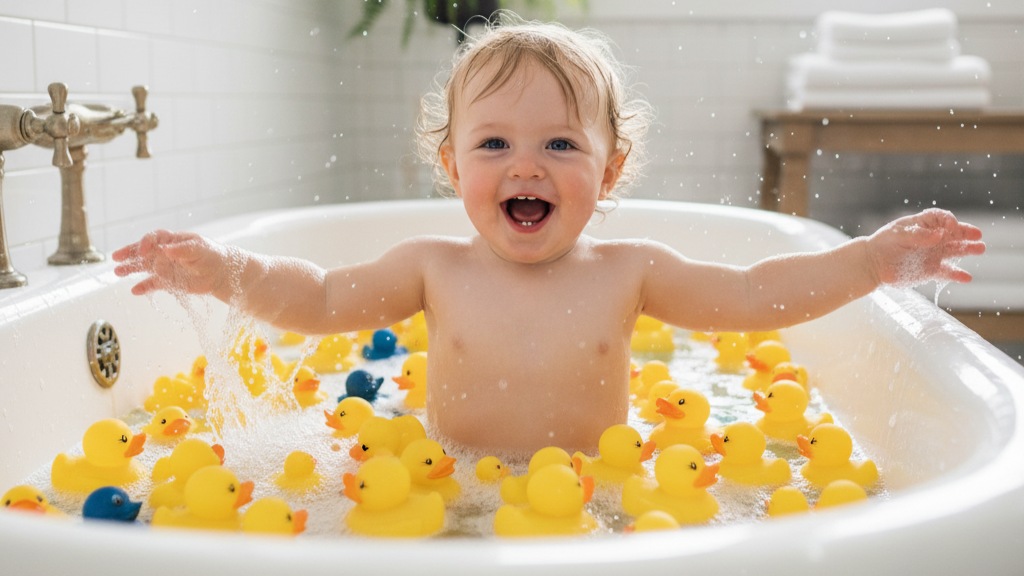Are Rubber Ducks Safe for Babies in the Bath?
⚠️ UPDATE: Looking for the latest safety standards on mold and materials? We have released a comprehensive 2025 deep-dive on this topic. Read our new guide here: The Hidden Danger in the Rubber Duck: A Parent’s Guide to Mold-Free & Non-Toxic Bath Toys.
Rubber ducks are a timeless bath toy, bringing joy to babies during bath time. However, concerns about mold, material safety, and choking hazards raise questions about their suitability for young children. With proper selection, cleaning, and maintenance, rubber ducks can be safe and fun for babies, ensuring a hygienic and worry-free bath experience. This guide explores the safety considerations for rubber ducks and shares practical tips to keep them clean and baby-friendly, aligning with your efforts to maintain a hygienic, eco-friendly bathroom.
Why Rubber Ducks Can Pose Risks
Rubber ducks, especially those with holes for squirting water, can trap moisture inside, creating a breeding ground for mold and bacteria in humid bathroom environments. Mold can appear as black or green spots and may trigger allergies or respiratory issues in sensitive babies. Some ducks are made from PVC, which may contain harmful chemicals like phthalates that can leach into bathwater, especially if chewed. Additionally, small parts or squeakers can pose choking hazards for babies under 3. Understanding these risks helps you choose and maintain safe rubber ducks.
How to Ensure Rubber Ducks Are Safe
Here are four key strategies to make rubber ducks safe for your baby, focusing on selection, cleaning, and maintenance.
1. Choose Hole-Free or Safe-Material Ducks
What to Do: Select solid, hole-free rubber ducks or those made from BPA-free, phthalate-free materials like natural rubber or silicone. Check labels for age recommendations (e.g., 6+ months) and certifications like “non-toxic” or “food-grade.”
Why It Works: Hole-free designs prevent water from getting trapped inside, reducing mold risk. Non-toxic materials ensure safety if babies chew on the toy, minimizing chemical exposure.
Best For: Babies who put toys in their mouths or households prioritizing eco-friendly, safe materials.
2. Clean Regularly with Non-Toxic Solutions
What to Do: Clean rubber ducks weekly to prevent mold and bacteria buildup. Use a 1:1 solution of white vinegar and warm water:
Submerge the duck, squeezing to fill any holes with the solution.
Soak for 1–2 hours, then scrub with a soft brush or toothbrush to remove mold.
Rinse thoroughly with clean water to remove vinegar residue.
Air-dry completely in a well-ventilated area or sunlight.
Why It Works: Vinegar kills mold spores and is safe for babies when rinsed well, aligning with eco-friendly cleaning practices.
Best For: Maintaining hygiene without harsh chemicals, especially for squirting ducks.
3. Dry Thoroughly After Each Use
What to Do: After every bath, squeeze out all water from squirting ducks and dry them with a clean towel. Place them on a rack or in a mesh bag to air-dry in a well-ventilated area, avoiding damp storage like sealed containers.
Why It Works: Thorough drying prevents moisture buildup, which mold needs to grow, keeping toys hygienic.
Best For: Preventing mold in bath toys used daily.
4. Ventilate the Bathroom
What to Do: Run an exhaust fan for 20–30 minutes after baths to reduce humidity, or open a window or door to improve airflow. This keeps the bathroom dry, reducing mold risk for toys and other surfaces.
Why It Works: Lower humidity inhibits mold and bacteria growth, creating a safer environment for bath toys and babies.
Best For: Households with humid bathrooms or frequent bath toy use.
Additional Safety Tips
Inspect Regularly: Check ducks for mold, cracks, or loose parts weekly. Discard toys with persistent mold or damage, as they may harbor bacteria or pose choking risks.
Seal Holes (Optional): Use hot glue to seal holes in squirting ducks to prevent water entry, though this stops the squirting feature. Alternatively, choose solid ducks designed without holes.
Limit Bath Time Exposure: Remove ducks from the bath immediately after use to minimize water absorption, especially for toys with holes.
Store Properly: Keep toys in a mesh bag or open basket to promote airflow, avoiding humid bathroom cabinets.
Monitor Baby’s Health: If your baby has mold allergies or asthma, consult a pediatrician about bath toy safety and consider mold-free alternatives like solid silicone toys.
When to Replace Rubber Ducks
If mold persists after cleaning (e.g., black stains inside holes, musty odor), or if the duck is made of questionable materials (e.g., unlabeled PVC), replace it to avoid health risks. Opt for solid, non-toxic designs to prevent future issues, ensuring your baby’s safety during bath time.
Why This Matters for Your Baby’s Safety
Rubber ducks can be safe for babies if chosen carefully and maintained properly. By selecting hole-free, non-toxic ducks and cleaning them regularly with natural solutions, you reduce mold and chemical risks, creating a hygienic bath environment. These practices align with eco-friendly bathroom habits, ensuring safety for your baby and sustainability for your home.
